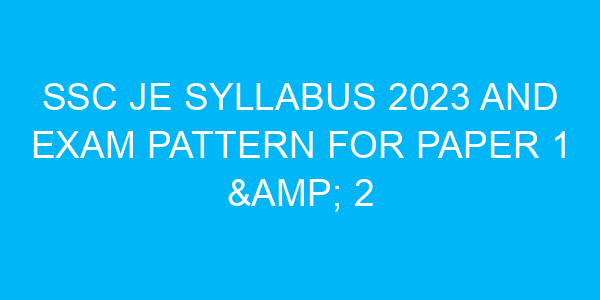SSC JE Syllabus 2023: Mastering the SSC JE Exam requires candidates to have a thorough understanding of the SSC JE Syllabus. Given the extensive nature of the syllabus, it is crucial for every candidate to familiarize themselves with each topic included in the SSC JE Exam. The SSC Junior Engineering (SSC JE) exam consists of two papers – Paper 1 and Paper 2. The Paper-I of the SSC JE 2023 exam is scheduled for October 2023. Candidates preparing for the SSC JE exam must be well-versed in the SSC JE Syllabus 2023, encompassing all relevant topics. This article provides a comprehensive overview of the SSC JE Syllabus and Exam Pattern for all engineering branches, including Civil, Electrical, and Mechanical.
SSC JE Syllabus 2023
The standard of the questions in Engineering subjects will be approximately of the level of a Diploma in Engineering (Civil/Electrical/Mechanical) from a recognized Institute, Board or University recognized by the All India Board of Technical Education. SSC has revised the exam pattern and this year SSC JE Paper 1 and Paper 2 both will be conducted in online mode i.e. Computer Based Test (CBT).
SSC JE Comprises two Tiers. The exam pattern of SSC JE is explained below:
| Papers | Type of Examination | Subjects | Mode of examination |
| Paper 1 | Objective Multiple Choice | (i) General Intelligence and Reasoning(ii) General Awareness(iii) Part-A General Engineering (Civil & Structural) or Part-B General Engineering (Electrical) or Part-C General Engineering (Mechanical) | CBT (Online) |
| Paper 2 | Objective Multiple Choice | Part-A General Engineering (Civil & Structural) Part-B General Engineering (Electrical) Part-C General Engineering (Mechanical) | CBT (Online) |
SSC JE Exam Pattern 2023 (Revised)
SSC JE Examination will consist of two papers i.e. Paper-I and Paper-II. As per the revised SSC JE Exam Pattern, both Paper-I and Paper-2 will be conducted online (Computer Based Examination). From this year onwards, Paper-I Exam is also an Objective Type of Paper that is to be held online. You need to check the exam pattern before going through the syllabus of SSC JE 2023.
SSC JE Paper-I Exam Pattern
| SSC JE Paper-I Exam Pattern | |||
| Subject | Number of Questions | Maximum Marks | Duration & Timings |
| General Awareness | 50 | 50 | 2 Hours |
| General Intelligence and Reasoning | 50 | 50 | |
| Part A- General Engineering (Civil & Structural) or Part B- General Engineering (Electrical) or Part C- General Engineering (Mechanical) or | 100 | 100 | |
| Total | 200 | 200 | |
Note: There will be a negative marking of 0.25 marks (revised) for each wrong answer in Paper-I.
SSC JE Syllabus for Paper-I
SSC JE 2023 Paper 1 is conducted in the online mode and has three sections which are mentioned below:
(i) General Intelligence and Reasoning
(ii) General Awareness
(iii) General Engineering- Civil and Structural, Electrical & Mechanical
1. SSC JE Syllabus for General Intelligence & Reasoning
SSC covers both verbal and non-verbal type questions in General Intelligence & Reasoning section. The test will also include questions designed to test the candidate’s abilities to deal with abstract ideas and symbols and their relationships, arithmetical computations and other analytical functions.
- Classification
- Analogy
- Coding-Decoding
- Paper Folding Method
- Matrix
- Word Formation
- Venn Diagram
- Direction and Distance
- Blood Relations
- Series
- Verbal reasoning
- Non-Verbal Reasoning
- Seating Arrangement
- Puzzles & Seating Arrangement
2. SSC JE Syllabus for General Awareness
Questions asked in this section will be aimed at testing the candidate’s general awareness of the environment around him/her and its application to society. Questions will also be designed to test knowledge of current events and of such matters of everyday observations and experience in their scientific aspect as may be expected of any educated person.
- Static General Knowledge
- Science
- Current Affairs
- Sports
- Books and Authors
- Important Schemes
- Portfolios
- People in the News
- History
- Culture
- Geography
- Economic
- Awards and Honors
3. SSC JE Syllabus for General Engineering (Civil and Structural), (Electrical & Mechanical):
Part-A: Civil Engineering
- Building Materials
- Surveying
- Estimating
- Soil Mechanics
- Costing and Valuation
- Concrete Technology
- Irrigation Engineering
- Steel Design
- Theory of Structures
- Hydraulics
- RCC Design
- Environmental Engineering
- Transportation Engineering
Part-B: Electrical Engineering
- Basic concepts
- Circuit law
- AC Fundamentals
- Magnetic Circuit
- Electrical Machines
- Utilization and Electrical Energy
- Transmission and Distribution
- Estimation and Costing
- Basic Electronics
- Generation
- Fractional Kilowatt Motors and single phase induction Motors
- Measurement and Measuring instruments
- Synchronous Machines
Part-C: Mechanical Engineering
- Theory of Machines and Machine Design
- IC Engines Combustion
- Air standard Cycles for IC Engines
- IC Engine Performance
- 1st Law of Thermodynamics
- 2nd Law of Thermodynamics
- Boilers
- IC Engine Cooling & Lubrication
- Classification
- Rankine cycle of System
- Specification
- Engineering Mechanics and Strength of Materials
- Centrifugal Pumps
- Basic Principles & Classification of steel
- Hydraulic Turbines
- Dynamics of Ideal fluids
- Fluid kinematics
- Measurement of Fluid Pressure
- Properties & Classification of Fluids
- Air Compressors & their cycles
- Refrigeration cycles
- Measurement of Flow rate
- Fluid Statics
- Nozzles & Steam Turbines
- Principle of Refrigeration Plant
- Fitting & Accessories
SSC JE Syllabus for Paper II
SSC JE Paper-II Exam Pattern
There will be a negative marking of 1 mark (revised) for each wrong answer in Paper-II.
| Subjects | No. of Questions | Maximum Marks | Duration & Timings |
| Part A- General Engineering(Civil & Structural) ORPart B- General Engineering (Electrical)ORPart C- General Engineering (Mechanical) | 100 | 300 | 2 Hours |
SSC JE Tier 2 Syllabus 2023
This paper consists of three parts as mentioned above. Tier II is a CBT exam of 100 questions with 3 marks each and in total 300 marks for a duration of 2 hours. Candidates have to attempt any of the following parts chosen by the respective candidate:
- Part-A (Civil Engineering & Structural Engineering)
- Part-B (Electrical Engineering)
- Part-C (Mechanical Engineering)
Candidates need to select any one of the parts which they wish to take during the exam. Basically, Tier II of the SSC JE syllabus includes a detailed explanation of each of the topics under each part as discussed in the General Engineering section of Paper I.
SSC JE Syllabus 2023 For Civil Engineering (Part A)
| SSC JE Syllabus For Civil Engineering | |
| Building Materials | Physical and chemical propertiesClassification, Standard Tests, Uses and Manufacture/Quarrying of Materials |
| Estimating, Costing, and Valuation | Estimate, a glossary of technical terms, analysis of rates, methods and unit of measurement, Items of work – earthwork, Brick work (Modular & Traditional bricks), RCC work, Shuttering, Timber work, Painting, Flooring, and Plastering.Boundary wall, Brick building, Water Tank, Septic tank, Bar bending schedule, Centre line method, Mid-section formula, Trapezoidal formula, Simpson’s rule.Cost estimate of Septic tank, flexible pavements, Tube well, isolates and combined footings, Steel Truss, Piles, and pile-caps.Valuation – Value and cost, scrap value, salvage value, assessed value, sinking fund, depreciation and obsolescence, methods of Valuation. |
| Surveying | Principles of surveying, measurement of distance, chain surveying.Working on the prismatic compass, compass traversing, bearings, local attraction, plane table surveying.The theodolite traversing, adjustment of theodolite, Leveling, Definition of terms used in leveling, contouring, curvature, and refraction corrections.Temporary and permanent adjustments of dumpy level, methods of contouring.Uses of a contour map, tachometric survey, curve settingEarthwork calculation, advanced surveying equipment. |
| Soil Mechanics | Origin of soil, phase diagram, Definitions-void ratio, porosity, degree of saturation, water content, the specific gravity of soil grains, unit weights, density index, and interrelationship of different parameters, Grain size distribution curves, and their uses.Index properties of soils, Atterberg’s limits, ISI soil classification, and plasticity chart.Permeability of soil, coefficient of permeability, determination of coefficient of permeability, Unconfined and confined aquifers, effective stress, quicksand, consolidation of soils, Principles of consolidation, degree of consolidation, pre-consolidation pressure, normally consolidated soil, e-log p curve, computation of ultimate settlement.Shear strength of soils, direct shear test, Vane shear test, Triaxial test.Soil compaction, Laboratory compaction test, Maximum dry density and optimum moisture content, earth pressure theories, active and passive earth pressures, Bearing capacity of soils, plate load test, standard penetration test. |
| Hydraulics | Fluid properties and hydrostatics, measurements of flow.Bernoulli’s theorem and its application.Flow-through pipes.Flow in open channels, weirs, flumes, spillways, pumps, and turbines. |
| Irrigation Engineering | Definition, necessity, benefits, 2II effects of irrigation, types, and methods of irrigation.Hydrology – Measurement of rainfall, runoff coefficient, rain gauge.Losses from precipitation – evaporation, infiltration, etc. Water requirement of crops, duty, delta and base period, Kharif and Rabi Crops, Command area, Time factor, Crop ratio, Overlap allowance, Irrigation efficiencies.Different types of canals, types of canal irrigation, loss of water in canals. Canal lining – types and advantages. Shallow and deep to wells, the yield from a well.Weir and barrage, Failure of weirs and permeable foundation, Slit, and Scour, Kennedy’s theory of critical velocity.Lacey’s theory of uniform flow.Definition of flood, causes, and effects, methods of flood control, water logging, preventive measure. |
| Transportation Engineering | Highway Engineering: cross-sectional elements, geometric design, types of pavements, pavement materialsAggregates and bitumen, different tests, Design of flexible and rigid pavementsWater Bound Macadam (WBM) and Wet Mix Macadam (WMM), Gravel Road, Bituminous construction, Rigid pavement joint, pavement maintenance, Highway drainage, Railway EngineeringComponents of the permanent way -Sleepers, ballast, fixtures and fastening, track geometry, points and crossings, track junction, stations, and yards.Traffic Engineering – Different traffic survey, speed-flow-density, and their interrelationships, intersections, and interchanges, traffic signals, traffic operation, traffic signs and markings, road safety. |
| Environmental Engineering | Quality of water, source of water supply, purification of water, distribution of water, need of sanitation, sewerage systems, circular sewer, oval sewer, sewer appurtenances, sewage treatments.Surface water drainage.Solid waste management – types, effects, engineered management system.Air pollution – pollutants, causes, effects, control.Noise pollution – cause, health effects, control. |
SSC JE Syllabus 2023 For Structural Engineering (Part A)
| SSC JE Syllabus For Structural Engineering | |
| Theory of Structures | Elasticity constants, types of beams – determinate and indeterminate, bending moment and shear force diagrams of simply supported, cantilever, and overhanging beams.Moment of area and moment of inertia for rectangular & circular sections, bending moment, and shear stress for tee, channel, and compound sections.Chimneys, dams and retaining walls, eccentric loads, slope deflection of simply supported and cantilever beams, critical load and columns, Torsion of circular section. |
| Concrete Technology | Properties, Advantages and uses of concrete, cement aggregates, the importance of water quality, water-cement ratioWorkability, mix design, storage, batching, mixing, placement, compaction, finishing and curing of concrete.Quality control of concrete, hot weather and cold weather concreting repair, and maintenance of concrete structures. |
| RCC Design | RCC beams-flexural strength, shear strength, bond strength, design of singly reinforced and double reinforced beams, cantilever beams.T-beams, lintels.One-way and two-way slabs, isolated footings. Reinforced brick works, columns, staircases, retaining walls, water tanks (RCC design questions may be based on both Limit State and Working Stress methods). |
| Steel Design | Steel design and construction of steel columnsBeams roof trusses plate girders. |
SSC JE Syllabus 2023 For Electrical Engineering (Part B)
| SSC JE Syllabus For Electrical Engineering | |
| Basic Concepts | Concepts of resistance, inductance, capacitance, and various factors affecting them.Concepts of current, voltage, power, energy, and their units.Circuit law: Kirchhoff‟s law, Simple Circuit solution using network theorems.Magnetic Circuit: Concepts of flux, mmf, reluctance, Different kinds of magnetic materials, Magnetic calculations for conductors of different configuration e.g. straight, circular, solenoidal, etc.Electromagnetic induction, self, and mutual induction. |
| AC Fundamentals | Instantaneous, peak, R.M.S., and average values of alternating waves.Representation of sinusoidal waveform, simple series and parallel AC Circuits consisting of R.L. and C, Resonance, Tank Circuit.Poly Phase system – star and delta connection, 3 phase power, DC and sinusoidal response of R-Land R-C circuit. |
| Measurement and Measuring Instruments | Measurement of power (1 phase and 3 phase, both active and re-active) and energy, 2 wattmeter method of 3 phase power measurement.Measurement of frequency and phase angle.Ammeter and voltmeter (both moving oil and moving iron type), the extension of range wattmeter, Multimeters, Megger, Energy meter AC Bridges.Use of CRO, Signal Generator, CT, PT, and their uses.Earth Fault detection. |
| Electrical Machines | D.C. Machine – Construction, Basic Principles of D.C. motors and generators, their characteristics, speed control, and starting of D.C. Motors. Method of braking motor, Loss, and efficiency of D.C. Machines.1 phase and 3 phase transformers – Construction, Principles of operation, equivalent circuit, voltage regulation, O.C. and S.C. Tests, Losses, and efficiency.Effect of voltage, frequency, and waveform on losses. Parallel operation of 1 phase /3 phase transformers.Autotransformers.3 phase induction motors, rotating magnetic field, the principle of operation, equivalent circuit, torque-speed characteristics, and starting and speed control of 3 phase induction motors.Methods of braking, the effect of voltage, and frequency variation on torque speed characteristics. |
| Fractional Kilowatt Motors and Single Phase Induction Motors | Characteristics and applications.Synchronous Machines – Generation of 3-phase e.m.f. armature reaction, voltage regulation, parallel operation of two alternators, synchronizing, control of active and reactive power.Starting and applications of synchronous motors. |
| Generation, Transmission, and Distribution | Power factor improvement, various types of tariffs, types of faults, short circuit current for symmetrical faults.Switchgears – the rating of circuit breakers, Principles of arc extinction by oil and air, H.R.C. Fuses, Protection against earth leakage / over current, etc. Buchholtz relay, Merz-Price system of protection of generators & transformers, protection of feeders and bus bars.Lightning arresters, various transmission and distribution systems, comparison of conductor materials, the efficiency of the different systems.Cable – Different types of cables, cable rating, and derating factor.Different types of power stations, Load factor, diversity factor, demand factor, cost of generation, inter-connection of power stations. |
| Estimation and Costing | Estimation of lighting scheme, electric installation of machines, and relevant IE rules.Earthing practices and IE Rules. |
| Utilization of Electrical Energy | IlluminationElectric heatingElectric weldingElectroplatingElectric drives and motors. |
| Basic Electronics | Working on various electronic devices e.g. P N Junction diodes, Transistors (NPN and PNP type) BJT, and JFET.Simple circuits using these devices. |
SSC JE Syllabus 2023 For Mechanical Engineering (Part C)
| SSC JE Syllabus For Mechanical Engineering | |
| Theory Of Machines and Machine Designs | Concept of a simple machine, Four bar linkage and link motion, Flywheels, and fluctuation of energyPower transmission by belts – V-belts and Flat belts, Clutches – Plate and Conical clutch, Gears –Type of gears, etc. |
| Engineering Mechanics and Strength of Materials | Equilibrium of Forces, Law of motion, Friction, Concepts of stress and strain, Elastic limit.Elastic constants, Bending moments and shear force diagram, Stress in composite bars, etc. |
| Thermal Engineering | Properties of Pure Substance1st & 2nd Law of ThermodynamicsAir standard Cycles for IC Engines.Rakhine Cycle of steamBoilers |
| Fluid Mechanics Machinery | Properties & Classification of fluidFluid StaticsMeasurement of Fluid PressureFluid KinematicsDynamics of Ideal FluidsMeasurement Of Flow Rate Basic PrinciplesHydraulic TurbinesCentrifugal PumpsClassification Of Steels |



